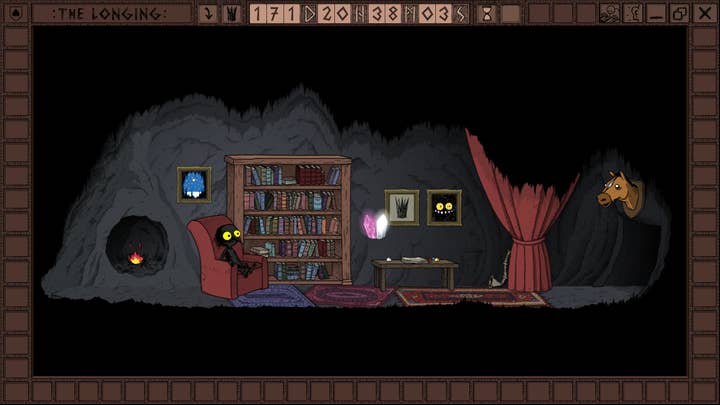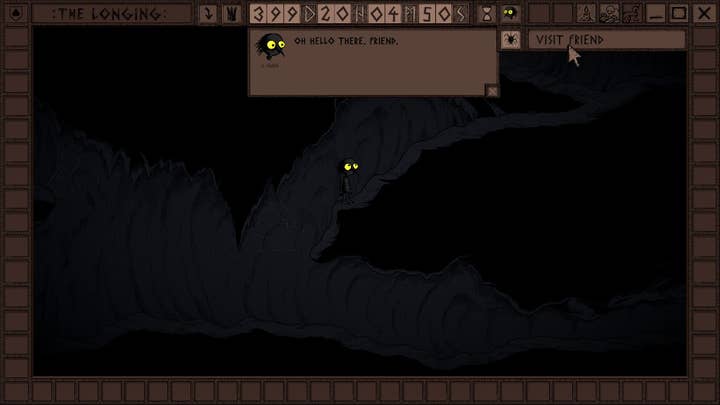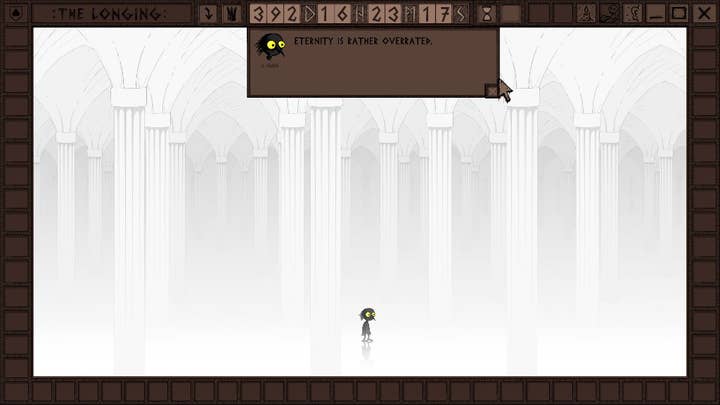Designing the end of all Longing
Studio Seufz's Anselm Pyta talks about his 400-day exploration/idle game, and the importance of time, empathy, and endings
Apropos to the work, Anselm Pyta has taken his time creating part-exploration, part-idle game, part-caretaking sim The Longing. Six years, to be precise.
Pyta's background lies in Flash animations and small titles released to Newgrounds going back as far as 2004. Over the next decade and a half, he and his friend Benedikt Hummel made several popular, free web games, studied animation and interactive media, and ultimately founded Studio Seufz in the beginning of 2017 to give their future creations a home. Though its works already span several short films and games, The Longing is Studio Seufz's first major release -- and Pyta's personal passion project.
Based loosely on a folk legend about the historical Holy Roman Emperor Frederick I, The Longing opens with a giant, underground king creating a tiny Shade, a servant for a singular purpose: the Shade must wake him in 400 days, so that he might sleep, recover his power, and eventually put an "end to all longing." He then goes to sleep, and a 400-day clock at the top of the screen begins to tick its way down.
The clock continues ticking in real-time, even when the game is shut and the computer is off, and the Shade is left to their fate. They can explore the king's palace, find objects to make their tiny cave home more comfortable, try to escape, or even do nothing at all.

Everything about the game is slow, from the Shade moving through mountain caverns at the pace of an elderly person with severe joint pain to the game's time-based puzzles that require you to wait hours, days, or even weeks for the environment to slowly shift and allow the Shade access to new areas. The Shade can pass the time by staring into space, drawing, or even reading classic works of literature in their entirety, such as Moby Dick, Thus Spoke Zarathustra, or The Iliad.
"The most basic form of waiting is being hit by a roadblock that slowly dissolves. But there are many other possibilities"
It's a game about waiting that's about to be released into a world where most games are deeply impatient, and often concerned with doing things as quickly or efficiently as possible.
"Time is hardly ever used in games as a mechanic and waiting is often seen as a nuisance," Pyta says. "But I figured with the right narrative context, it could work to create empathy and emotion. The greatest challenge is to find different ways to incorporate waiting, without too much redundancy. The most basic form of waiting is being hit by a roadblock that slowly dissolves. But there are many other possibilities: What if you have to wait only in a specific place? During a specific time of day? What if you have to catch the right moment of a specific waiting period? Using time as a game design tool gives one many possibilities."
At least some of Pyta's inspiration for The Longing came from traditional idle games, which he feels have one key flaw: they never end. With this game, Pyta wanted to replicate the gameplay style, but add stakes to encourage an emotional response from audiences.

"The ending changes everything," he says. "Typically, finishing something and reaching the final goal gives players the highest emotional reward -- even if they are not actively engaging in the experience, although that certainly benefits the outcome. If this moment never comes, the player will eventually feel cheated of their highest victory and just leave with a negative feeling.
"On the other hand, you could argue for endless games being able to get you into a Sisyphos mindset, where you accept the eternal struggle of life and find happiness in endless repetition -- but this certainly doesn't work for me and sounds more like the perfect way to become dead inside."
"If someone is traumatized by what you deem to be emotionally true, it's maybe a little too early for them to experience this in their life"
Four hundred days of waiting is a long time. Though it can be sped up -- or even paused -- by certain activities in the game, this is an extremely lengthy piece of content to playtest both generally, but also for player frustration or boredom. Pyta tells me he used a lot of "gut feeling" to gauge how to pace The Longing to keep players from giving up, though he did test the game with others as well.
"I found that the comments of the character can be quite helpful in giving the player something to latch on to," he says. "If the character is bored and wants to give up, the player feels empathy and will try to better the situation."
Pyta talks consistently through our interview about empathy, something that comes across especially in The Longing's take on player choice. The player can ignore the Shade entirely for 400 days, or try to make their life more comfortable by acquiring furnishings for their cave, more books and art, and accomplishing the Shade's goals as written in their journal. Doing so makes the seconds on the clock tick by a bit faster, and gives the Shade more positive responses to life in the underground.
"I think this is important to show the subjectivity of time, since the happy days always seem to be the most fleeting," Pyta says. "It also fits really well with the dualistic approach of the game: do you want to align yourself with the life in the cave, or do you want to escape? If you find happiness down there and keep yourself occupied, naturally you will be able to endure the wait much more easily."

But during my own playthrough of The Longing, I also encountered options to encourage the Shade to take a different turn: one toward despair. Though I won't spoil one of the game's eventual possibilities, The Longing does contain content that can be upsetting or disturbing in its implications and how it handles the Shade's loneliness. Why, in a game that can be played in such a cozy and kind manner, would players be given the option to explore deep despair?
"In a game about loneliness it would be dishonest not to show the despair that may come with it in certain situations," Pyta says. "You will notice that the cave gets darker and darker the further you get away from your starting point, until you are faced with utter blackness. This is the journey to overcome loneliness. Some get lost in the abyss, but some make it to the light by overcoming themselves and their fears."
I ask Pyta if he has any concerns that players might find such depictions to be emotionally difficult.
"You never know how some people might react to your work as an artist," he responds. "I think it's just important to be honest with the audience and show them what you feel, so they can relate. If someone is traumatized by what you deem to be emotionally true, it's maybe a little too early for them to experience this in their life. But ultimately, there should be no self-censorship."

Because The Longing takes 400 days -- give or take -- to complete, it's not designed for multiple playthroughs. But Pyta has doubled down on this philosophy, telling reviewers and interviewers and others that it's meant to be played only once despite having several, unique endings. Though he can't stop players from resetting once they finish, he hopes they'll be content to sit with the choices they made, and walk away.
"Being able to restart and undo our actions devalues the choices made, which is a common problem in video games"
"Being able to restart and undo our actions devalues the choices made, which is a common problem in video games," he says. "I figured with a game like this, it's easier to encourage settling on one playthrough, because we all know that there's no going back in time. 'Rewinding' the clock is ultimately self-deception, and the game would lose a lot of its melancholy and emotional weight. If emotions are what we are looking for in games, we should not ruin ourselves by cheapening them willfully. It's impossible to prevent players from doing a reset, but I hope some of them will understand my approach."
I ask if he'd want to apply this approach to other games too, even ones that don't have the same structure and themes of The Longing.
"I think this was already brought up in the famous 'Video games can never be art' essay by the late Roger Ebert, who claimed that a tragedy like Romeo and Juliet would not work in a game, because a video game life constantly devalues itself," Pyta says [Author's note: The specific reference to Romeo and Juliet appears in Ebert's responses to a speech by Clive Barker at the 2007 Hollywood and Games Summit]. "You simply restart the game or respawn and there the characters are, back to life again, and maybe you can even make other choices to prevent their deaths.
"This is of course ignorant, but it's true that this can be a problem for a game trying to convey very harrowing emotions. To most players, the real tragedies happen only when they lose the save file of their level 60 Diablo character or something like that. I'd say that the roguelike genre has a very interesting approach to this, by creating a unique world that is forever destroyed after the player restarts.
"There is certainly potential for real tragedy there! But I've not yet played a game that executed this idea to the fullest."

